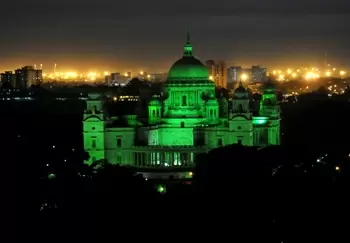A finest example of European architecture with an Indian touch is not open to all
15-June-2015
Vol 6 | Issue 24
It might not be as grand as the Victoria Memorial, perhaps the best known symbol of this eastern metropolis, but the Marble Palace is one of the finest examples of European architecture with an Indian touch - and an eye-opener on 19th century grandiosity.
Approachable through a dingy north Kolkata lane and perhaps not too well known because entry is restricted, the mansion, known for its marble flooring and marble decor wall panels, houses 76 rare artworks brought in 1830 all the way from Italy and Belgium.
 |
|
For lovers of European art, Marble Palace is a must-visit place in Kolkata (Photo: IANS)
|
The palace is a treasure trove of valuable art objects collected over the past 180 years.
It seldom gets visitors as entry is possible only after the West Bengal State Tourism Department issues a permit after asking searching questions on one's knowledge of art. (I got in on the basis of my press card).
This is just fine for the 15 people - the descendants of Raja Rajendra Mullick (1819-1887), an affluent businessman who had the palace built between 1830 and 1835 - who maintain the building. Fewer visitors mean less maintenance.
"People who value art, culture and heritage have a knack about the European art and love the palace," said Hirendra Mullick, a sixth generation descendant of the Mullick family.
"Moreover, people are less concerned about art nowadays. Definition of art and culture has also changed," Hirendra added, citing the reason behind the restricted entry to the palace.
The palace is divided into five halls - Reception Hall, Painting Room, Sculpture room, Billiards Room and Thakur Dalan (place of worship).
The palace takes one to the Victorian era with its beautiful decor and eye-catching collection. The museum has sculptures from Praxiteles to Phidias, Venus to Apollo, Homer to Diana and Mosses.
There is also an enormous Japanese bronze vase in the doorway that immediately catches one's attention. The walls are adorned with full-length Belgian glass mirrors, enhancing the beauty of the palace.
Also on view is a two-cornered bicorne of the kind Napoleon Bonaparte wore during his military campaigns. It is said to be an original but no one is too sure about this - or how it got here.
"Research scholars who are interested to know about art are always welcome here. Marble Palace is for those who are interested to know about the evolution of art," Hirendra noted.
The Reception Hall has sculptures depicting Autumn and Spring; Agriculture and Commerce; Summer and Winter; and Dawn and Night. Some of these are originals, brought from the Italian and British schools, while some are replicas.
"The collection is an effort of the past 180 years. With time, the descendants have added many sculptures and paintings, both original and replicas depending upon the budget," Hirendra said.
Then there is a dimly-lit room dedicated to paintings belonging to the Victorian age like the "Marine View" by Dutch painter Jan Van Goyen, "Madonna with Child" by Italian painter Giovanni Battista Salvi da Sassoferrato, "The Mystic Marriage of St. Catherine" by Rubens and "The Martyrdom of St. Sebastian" by Piero del Pollaiolo, as also some paintings by famous Indian artist Raja Ravi Varma.
The Marble Palace also has what is perhaps the first Indian private zoo which is now open to visitors. The animals are carnivores as non-vegetarian food is not allowed within the premises.
Has Marble Palace missed out on the fame achieved by palaces like that in Mysuru (Mysore)?
According to Hirendra, Marble Palace cannot be compared with other royal palaces.
"The purpose of Marble Palace was to create a place for those who have a keen interest in art. Other palaces were built for status-flaunting. Raja Rajendra Mullick wanted art lovers to get acquainted with European art forms, particularly post-renaissance art," Hirendra stated.
Revenue for maintenance is not an issue for its keepers as they collect funds from their other landed properties.
"The major problem is regular cleaning of the artworks which is not possible as we have less staff. Cleaning also requires experts so that these precious objects are not ruined," Hirendra explained.
Photography inside the museum is strictly prohibited. To ensure that one doesn't click any pictures, palace staff always accompanies visitors.
"It is to avoid those who want to purchase our valuable collection. If selling would have been in our mind, we would not have spent so much effort to maintain the museum," he said.
Still, the palace could do with some renovation.
Many art objects have been added in recent years to the collection and the descendants plan to buy more after careful thought.
The Marble Palace may not enjoy the attention as other palaces or museums do, but a visit will be well worth for those who truly love European art.
FAQs:
Location: Mukhtaram Babu Street, M.G. Road, Kolkata.
Timings: 10 a.m.-4 p.m. (Monday and Thursday closed).
Entry - Free but special permit from the West Bengal State Tourism Department is required. - IANS














